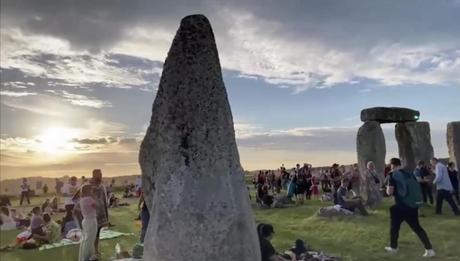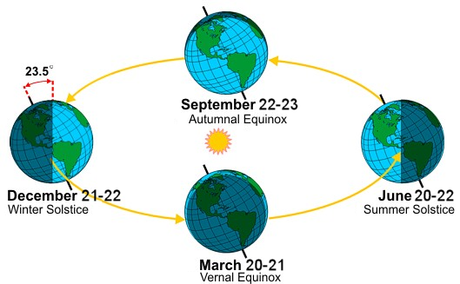The summer solstice Thursday marks the end of spring in the Northern Hemisphere and the start of a brand new season, one that promises more warmth and more sunlight. To mark the transition to summer 2024, the astronomical event serves as a kind of grand opening: everywhere above the equator it will be the longest day of the year.
At Stonehenge, a prehistoric monument of massive stones that is now a protected heritage site in southern England, historians believe that ancient people built a ceremonial circular structure of huge sarsen stones with a specific purpose to honor and celebrate the solstice.

Stonehenge was mysteriously built around 2500 BC. The stones were erected and carefully arranged in the late Neolithic period, a period when creating such a monument would have been a brilliant feat of advanced construction and engineering.
For a person standing at the center of Stonehenge, the layout is oriented so that the stones frame with precision the sunrise on the summer solstice and the sunset on the day. winter solstice. Thousands of people come to the site every year during both solstices to witness the phenomenon with their own eyes.
Just a day before this year's summer solstice, climate protesters Stonehenge sprayed with orange paint to make a statement against fossil fuels. The organization that manages the Stonehenge site, English Heritage, told CBS News that the incident was "extremely disturbing and our curators are investigating the extent of the damage", but that the monument remained open to the public.
What is the summer solstice?
The solstice technically kicks off summer in the Northern Hemisphere, while its converse, the Winter Solstice, simultaneously kicks off winter in the Southern Hemisphere.
It occurs when the Earth, which is tilted 23.5 degrees on its axis, reaches the maximum point at which the northern half of the planet has been tilted toward the sun since the summer solstice last occurred. Because the Earth continually rotates on its axis and revolves around the sun at the same time, this tilt gives each hemisphere the chance to bathe in the longest amount of daylight just once a year.
Seasons exist on Earth due to the 23.5 degree tilt. As the planet rotates and completes its orbital path about 365 daysEarth's tilted axis means that the angles at which different parts of its surface face the sun shift throughout the year. During the Northern Hemisphere summer solstice, which usually falls on June 20 or 21 (it's June 20 this year), those cosmic mechanics push the planet's top forward toward the sun. At the North Pole it starts with six months of daylight, while at the South Pole it means six months of darkness.


Conditions reverse six months later, when Earth reaches a point in its orbit where its axis tilts backward so that the south pole is closest to the sun. On that day, usually December 21 or 22, the winter solstice brings the shortest period of daylight in the Northern Hemisphere, while in the Southern Hemisphere summer begins.
In December, crowds gathered at Stonehenge to also celebrate the winter solstice.
Why is June 20 the longest day of 2024?
The North Pole is never as tilted towards the sun as it is during the summer solstice. This pronounced tilt exposes more of the Northern Hemisphere to sunlight at any given time than at any other point in Earth's revolution. From the perspective of a person on the ground, that exposure provides the longest period of daylight in 24 hours that can occur all year round.
According to the National Oceanic and Atmospheric Administration, the North Pole will reach its most extreme tilt this year at 4:51 PM EDT on June 20. The sun is then directly above the Tropic of Cancer, a longitudinal line wrapping horizontally around the circumference of the Earth at 23.5 degrees above the equator. The line passes through Mexico, the Bahamas, Egypt, Saudi Arabia, India and southern China.
At the other end of the cycle, when the North Pole is tilted as far away from the sun as possible, the portion of the Northern Hemisphere that sunlight can reach is as small as it can get. Therefore, the winter solstice is the shortest day of the year for people above the equator, and the longest day of the year for people below.
How the summer solstice has been celebrated throughout history
The summer solstice is an event that civilizations have observed and celebrated for millennia. Historians believe the Neolithic people who built Stonehenge were part of a broader ancient culture in northern and central Europe that, experts say, seemed to recognize the solstice and the changing seasons in relation to agriculture and, possibly, the timing of harvest cycles .
The British nonprofit National Trust writes in a review of ancient solstice traditions that the event was "typically marked by Celtic, Slavic and Germanic peoples by lighting bonfires, intended to increase the power of the sun for the remainder of the harvest season and to guarantee a healthy harvest. Other Neolithic stone circles, similar to Stonehenge, also appear to have been built with the solstices in mind, according to the organization.
Today, people mark the solstice with their own takes on the traditional ceremonies of ancient times. Festivals and bonfires are common in communities around the world. But there are countless ways that modern humans recognize Earth's seasonal transition. Depending on where it takes place, a summer solstice celebration can look like a midnight baseball game in Fairbanks, Alaska, or last all day. massive yoga gathering in Times Square.
Former acting director of the CIA warns that the US is facing a serious terrorist attack
Video shows what a Saudi national filmed before the September 11 terror attacks | 60 minutes
Video of Omar al-Bayoumi revealed in federal court | 60 minutes
